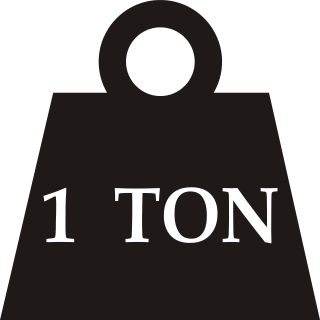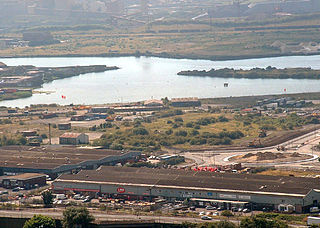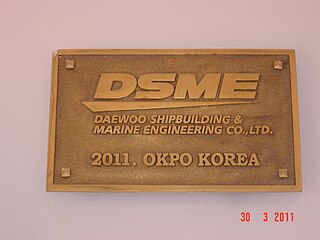Related Research Articles

Ton is the name of any one of several units of measure. It has a long history and has acquired several meanings and uses.

A container ship is a cargo ship that carries all of its load in truck-size intermodal containers, in a technique called containerization. Container ships are a common means of commercial intermodal freight transport and now carry most seagoing non-bulk cargo.
Tonnage is a measure of the cargo-carrying capacity of a ship, and is commonly used to assess fees on commercial shipping. The term derives from the taxation paid on tuns or casks of wine. In modern maritime usage, "tonnage" specifically refers to a calculation of the volume or cargo volume of a ship. Although tonnage (volume) should not be confused with displacement, the long ton of 2,240 lb is derived from the fact that a "tun" of wine typically weighed that much.

The twenty-foot equivalent unit is an inexact unit of cargo capacity, often used for container ships and container ports. It is based on the volume of a 20-foot-long (6.1 m) intermodal container, a standard-sized metal box which can be easily transferred between different modes of transportation, such as ships, trains, and trucks.

A cargo ship or freighter is a merchant ship that carries cargo, goods, and materials from one port to another. Thousands of cargo carriers ply the world's seas and oceans each year, handling the bulk of international trade. Cargo ships are usually specially designed for the task, often being equipped with cranes and other mechanisms to load and unload, and come in all sizes. Today, they are almost always built of welded steel, and with some exceptions generally have a life expectancy of 25 to 30 years before being scrapped.

A merchant ship, merchant vessel, trading vessel, or merchantman is a watercraft that transports cargo or carries passengers for hire. This is in contrast to pleasure craft, which are used for personal recreation, and naval ships, which are used for military purposes.

A bulk carrier or bulker is a merchant ship specially designed to transport unpackaged bulk cargo—such as grain, coal, ore, steel coils, and cement—in its cargo holds. Since the first specialized bulk carrier was built in 1852, economic forces have led to increased size and sophistication of these ships. Today's bulk carriers are specially designed to maximize capacity, safety, efficiency, and durability.

Umiak I is a purpose-built ice-strengthened bulk carrier constructed for the Voisey's Bay Nickel Company, a wholly owned subsidiary of Vale, to transport ore from the Voisey's Bay Mine.

Handysize is a naval architecture term for smaller bulk carriers or oil tanker with deadweight of up to 50,000 tonnes, although there is no official definition in terms of exact tonnages. Handysize is also sometimes used to refer to the span of up to 60,000 tons, with the vessels above 35,000 tonnes referred to as Handymax or Supramax.

The port of Port Talbot is located on the River Afan estuary next to Port Talbot Steelworks in the industrial town of Port Talbot, South Wales. The whole basin complex covers about 500 acres (2.0 km2), consisting of: an inner set of floating docks, developed from 1834 onwards; and an outer tidal basin, completed in 1970. Owned and operated by Associated British Ports, the tidal basin has the deepest berthing facilities in the Severn estuary and is one of only a few harbours in the UK capable of handling Capesize vessels of up to 170,000 tonnes deadweight (DWT), mostly for the import of iron ore and coal for use by nearby Port Talbot Steelworks.

An oil tanker, also known as a petroleum tanker, is a ship designed for the bulk transport of oil or its products. There are two basic types of oil tankers: crude tankers and product tankers. Crude tankers move large quantities of unrefined crude oil from its point of extraction to refineries. Product tankers, generally much smaller, are designed to move refined products from refineries to points near consuming markets.

MV Rocknes was a 166-metre (545 ft)-long rock discharge vessel that hit shallow water and suddenly capsized south of Bergen, Norway on 19 January 2004, killing 18 members of its 30-person crew. At the time of its sinking, it was the world's largest dynamically positioned flexible fall pipe rock dumping vessel. The ship was repaired during 2004 and 2005 and renamed Nordnes.

MV Osakana is an open hatch bulk carrier that was built in 2004 by Oshima Shipbuilding as Star Osakana for Masterbulk.
Ship measurements consist of a multitude of terms and definitions specifically related to ships and measuring or defining their characteristics.

MS Ore Brasil, previously known as Vale Brasil, is a very large ore carrier owned by the Brazilian mining company Vale. She is the first of seven 400,000-ton very large ore carriers (VLOC) ordered by Vale from Daewoo Shipbuilding & Marine Engineering in South Korea and twelve from Jiangsu Rongsheng Heavy Industries in China, which are designed to carry iron ore from Brazil to Asia along the Cape route around South Africa. While close to the specifications of Chinamax, these ships are generally referred to as Valemax vessels by Vale. They are the largest bulk carriers ever built.

Valemax ships are a fleet of very large ore carriers (VLOC) owned or chartered by the Brazilian mining company Vale S.A. to carry iron ore from Brazil to European and Asian ports. With a capacity ranging from 380,000 to 400,000 tons deadweight, the vessels meet the Chinamax standard of ship measurements for limits on draft and beam. Valemax ships are the largest bulk carriers ever constructed, when measuring deadweight tonnage or length overall, and are amongst the longest ships of any type currently in service.

MV Vale Rio de Janeiro, owned by the Brazilian mining company Vale, is one of the world's largest very large ore carriers and a sister ship of Vale Brasil. Designed to carry iron ore from Brazil to Asia along the Cape route around South Africa, she is the second of seven 400,000-tonne very large ore carriers (VLOC) ordered by Vale from Daewoo Shipbuilding & Marine Engineering in South Korea and twelve from Jiangsu Rongsheng Heavy Industries in China. While close to the specifications of Chinamax, these ships are generally referred to as Valemax vessels by Vale.

Thunder Bay is a Trillium-class lake freighter cargo vessel, built and launched in China in 2013. The ship is owned, and operated on the Great Lakes, by the Canada Steamship Lines (CSL). Like her three sister ships in CSL's Trillium class, Baie St. Paul, Baie Comeau, and Whitefish Bay, the vessel is a self-unloading bulk carrier, with a conveyor belt on a long boom that can be deployed over port or starboard sides.
Nunavik is an icebreaking bulk carrier owned and operated by the Canadian shipping company Fednav. She is used to transport copper and nickel from the Nunavik Nickel Project, making 7–8 round trips per year.

The Trillium class is a series of freighters owned by Canada Steamship Lines (CSL). The class is divided into three subclasses; the self-discharging lake freighters, the lake bulk carriers, and the Panamax self-discharging bulk carriers. Initially a nine-ship building program, six are operated by Canada Steamship Lines for use on the Great Lakes, while three are operated by CSL Americas for international trade. Two more ships were acquired later for use by CSL Americas.
References
- 1 2 3 Stopford, M. Maritime Economics. Third Edition. Roudledge, 2009. Pages 575–576.
- ↑ Stowage factor. Transport Information Service (TIS). Retrieved2011-04-11.
- ↑ "Stowage Factor (SF) | HandyBulk". 6 January 2022.